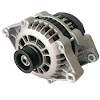Tidal power plant
The tide is the regular rising and falling of the Ocean’s
surface caused by changes in gravitational forces external to the Earth. The
primary changing gravitation field is due to the Moon While the secondary field
caused by sun.
Tidal coming out
Fig: Tidal power
The maximum water level is called High Tide; the minimum level is Low tide and high tide is called flow, flood, or rising tide. At
any given point on the ocean, there are normally two high tides and two low
tides each day. On average, high tides occur 12 hours 24 minutes apart. The 12
hours is due to the Earths rotations, and the 24 minutes to the moons orbit.
Tidal power is a means of electricity generator achieved by capturing the energy contained
in moving water mass due to tides. Two types of tidal energy can be extracted:
kinetic energy of current due the tides and potential energy from the
difference in height (or head) between high and low tides.
Construction and
working of Tidal power plant:
The extraction of potential energy involves building a
barrage. The barrage traps a water level inside a basin. Head is created when
the water level outside of the basin changes relative to the water level
inside. The head is used to drive turbines. In any design this leads to a
decrease of tidal rang inside the basin, implying a reduced transfer of water
between the basin and the sea. This reduced transfer to water accounts for the
energy produced by the scheme. The dam has largest gates in it and for storing
water in the storage basin the gates are opened at the time of high tide and
after storing water the gates are closed. After the tide has receded, the water
is allowed to flow back to the ocean through water turbine. Thus the tidal energy
stored at height can be utilized to drive a turbine coupled to an electric
generator, which generates electrical power. By using reversible water turbine
the turbine can run continuously both during high tide and low tide. The principle
of operation is illustrated in bellow finger.
Advantages of Tidal power
1 It is free from pollution and tidal power is free.
2. It produces no greenhouse gases or other waste.
3. It needs no fuel and it is inexhaustible.
4. In produces electricity reliably because it doesn’t depend on rain.
5. Not expensive to maintain.
6. Tides are totally predictable and independent of monsoon or summer.
7. These plants do not demand area of valuable land because they are in the bay (sea shore).
8. Provide fish farming in tidal base.
9. It doesn’t produce any waste like ash, gases etc.
Disadvantages of Tidal power:
1. Power plants will be far away from load centers.
2. Require more capital than Hydro-electric plant (5000/- per kw).
3. Continuous more power generation is not possible because it depends on Tides.
4. Navigation/shipping may be obstructed.
5. Sedimentation and filtration of the basic is problem.
6. Sea water is corrosive and it was feared that the machinery might get corroded.
7. A barrage across an estuary is very expensive to build, and affects a very wide area the environment is changed for many miles upstream and downstream.
8. Only provides power for around 10 hours each day, when the tide is actually moving.












0 Comments